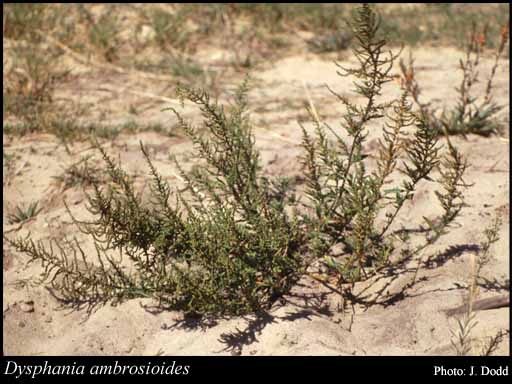- Reference
- Ukryains'k.Bot.Zhurn. 59:382 (2002)
- Conservation Code
- Not threatened
- Naturalised Status
- Alien to Western Australia
- Name Status
- Current







Distribution
- IBRA Regions
- Esperance Plains, Jarrah Forest, Swan Coastal Plain, Warren.
- IBRA Subregions
- Perth, Recherche, Southern Jarrah Forest, Warren.
- IMCRA Regions
- Leeuwin-Naturaliste, WA South Coast.
- Local Government Areas (LGAs)
- Albany, Bridgetown-Greenbushes, Bunbury, Busselton, Cambridge, Canning, Cockburn, Dardanup, Donnybrook-Balingup, Esperance, Fremantle, Gosnells, Harvey, Mandurah, Manjimup, Murray, Perth, Plantagenet, Rockingham, Serpentine-Jarrahdale, South Perth, Stirling, Vincent.
Management Notes (for the Swan NRM Region)
Alternative Names. Common Lambsquarters.
General Biology. Growth form. Herb. Life form. Annual. Reproduction. Seed. Dispersal. Birds, machinery, soil movement, wind (small distances only). Toxicity. In nitrogen-rich soils can concentrate hydrogen cyanide. Seedbank persistence. 20-40 years.
Notes. Infestations may be very dense and compete vigorously with other plants. Prefers disturbed highly organic nitrate-rich soil and requires bare ground for establishment and persistence. Flowers are hermaphrodite (have both male and female parts) and are wind-pollinated. Rain, nitrate and light promote germination. Several generations may occur in one season due to rapid growth and seed production. Strongly allelopathic, capable of reducing germination and growth of other species. Exhibits great morphological plasticity and is able to adapt to different environments including shade by delaying seed set, growing taller and having greater leaf area. Produces a high proportion of dormant seed with no special dispersal mechanism.
Additional information. History of use/introduction. Medicines, dyes, food. Similar exotic species. Chenopodium murale.
Suggested method of management and control. Manual removal, particularly when plants are young, is effective due to shallow root systems, and can be done up to stem elongation and before seeding in summer. Highly susceptible to mowing/slashing before flowering. Relatively tolerant to many herbicides and any sub-lethal rates of herbicide will result in the same high seed germination rates as unsprayed plants. Read the manufacturers' labels and material safety data sheets before using herbicides. For further information consult the Australian Pesticides and Veterinary Medicines Authority to determine the status of permits for your situation or state.
Management Calendar
| Calendar Type | Jan | Feb | Mar | Apr | May | Jun | Jul | Aug | Sep | Oct | Nov | Dec | Comments |
|---|---|---|---|---|---|---|---|---|---|---|---|---|---|
| Germination | O | O | O | Y | Y | Y | O | O | O | O | O | O | |
| Active Growth | Y | Y | Y | Y | Y | Y | Y | Y | Y | Y | Y | Y | |
| Flowering | O | O | Y | Y | O | O | Y | Y | Y | ||||
| Fruiting | Y | Y | Y | Y | |||||||||
| Optimum Treatment | O | O | O | O | Y | Y | Y | Y | Y | Y | Y | O |
Legend: Y = Yes, regularly, O = Occasionally, U = Uncertain, referred by others but not confirmed.
References
- Bassett, I.J. & Crompton, C.W. (1978) The biology of Canadian weeds. 32. Chenopodium album L. Canadian Journal of Plant Science, 58: 1061-1072.
- Bouwmeester, H.J. & Karssen, C.M. (1993) Seasonal periodicity in germination of seeds of Chenopodium album L. Annals of Botany, 72: 463-473.
- Brown, K. & Brooks, K. (2002) Bushland Weeds: A Practical Guide to their Management. Environmental Weeds Action Network, Greenwood.
- Brown, K. & Brooks, K. (2002) Bushland Weeds: A Practical Guide to their Management. Environmental Weeds Action Network, Greenwood.
- Deparment of Animal Science (2008) Medicinal plants for livestock: Chenopodium ambrosioides. Cornell University URL: http://www.ansci.cornell.edu/plants/medicinal/index.html - Accessed August 2010.
- Dixon, B. & Keighery, G. (1995) Weeds and their control. In Managing Perths bushlands (eds. M. Scheltema and J. Harris). Greening Western Australia, Perth.
- Hegazy, A.K. & Farrag, H.F. (2007) Allelopathic potential of Chenopodium ambrosiodes on germination and seedling growth of some cultivated and weed plants. Global Journal of Biotechnology, 2 (1): 1-9.
- Hussey, B.M.J., Keighery, G.J., Dodd, J., Lloyd, S.G. & Cousens, R.D. (2007) Western Weeds. A guide to the weeds of Western Australia. 2nd Edition. The Plant Protection Society of Western Australia, Victoria Park.
- Hussey, B.M.J., Keighery, G.J., Dodd, J., Lloyd, S.G. & Cousens, R.D. (2007) Western Weeds. A guide to the weeds of Western Australia. 2nd Edition. The Plant Protection Society of Western Australia, Victoria Park.
- Jafari, L., Kholdebarin, B. & Jafari, E. (2007) Phytotoxic effects of a Chenopodium album L. water extract on higher plants. American Journal of Plant Physiology, 2 (3): 221-226.
- Jimenez-Osornio, F.M.V.Z.J., Kumamoto J. & Wasser, C. (1996) Allelopathic activity of Chenopodium ambrosioides L. Biochemical Systematics and Ecology, 24 (3): 195-205.
- JingRong, W., DanWei, M. & Lin, T. (2009) Allelopathy of volatile oil from Chenopodium ambrosioides L. on receptors. Southwest China Journal of Agricultural Sciences, 22 (3): 777-780.
- Mahoney, K.J. & Swanton, C.J. (2008) Exploring Chenopodium album adaptive traits in response to light and temperature stresses. Weed Research, 48: 552-560.
- Moore, J.H. & Wheeler, J. (2008) Southern weeds and their control. DAFWA Bulletin 4744.
- Plants for a Future (Undated) Chenopodium album - L. Fat Hen. URL: http://www.pfaf.org/database/plants.php?Chenopodium+album - Accessed April 2010.
- Rezaie, F. (2009) Allelopathic effects of Chenopodium album, Amaranthus retroflexus and Cynodon dactylon on germination and growth of safflower. Journal of Food and Agriculture & Environment, 7 (2): 516-521.
- Tanveer, A., Nadeem, M.A., Ali, A., Tahir, M. & Zamir, M.S.I. (2009) Germination behaviour of seeds from herbicide treated plants of Chenopodium album L. Annals of the Brazilian Academy of Sciences, 81 (4): 873-879.
- Westhoven, A.M. (2008) Management of glyphosate-tolerant common Lambsquarters (Chenopodium album) in glyphosate-resistant Soybean. Weed Technology, 22 (4): 628-634.
- Williams, J.T. (1963) Chenopodium album L. Journal of Ecology, 51 (3): 711-725.